 |
||
|
||
| ||
Most companies dealing with mainboards and other PC components have already released their own barebone systems. I can't assert that the future belongs to such kind of a PC, but the market is not filled up with them yet, and new models keep on flowing in. At the same time it's not necessary to work out a unique design: OEM orders are readily accepted, and the direction is already determined by Shuttle' XPC. Its conception is so popular that many developers make only slight changes in the design of the systems ordered from Shuttle. Certainly, they put inside their own mainboards, sales of which is actually what makes them deal with this type of computer. Today we have 4 relatively new models of the classical design: a small PC case plus a small board, i.e. actually a set of components. But in future we will deal with more interesting mini computers: MSI MegaPC, which can be an independent player of media contents, and some unique models from ECS Elitegroup. Today we have 3 cubes and a classical desktop PC from ASUSTeK! ASUS Pundit (AB-P2600)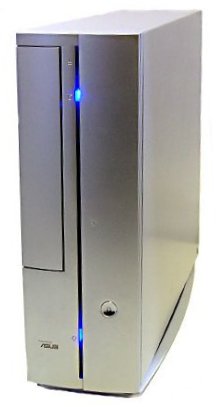 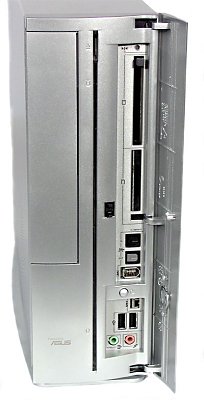 Its body follows the classical desktop style and measures 275x357x91mm. It can stand vertically, and there is a support with 6 plastic legs attached to the side panel. The metallic color plus two blue LEDs indicating the system's and hard drive's status, make a positive impression of its exterior. Multiple inputs/outputs are covered with a lid, which retains the stylish appearance until the connectors are used. The problem of color matching is solved the best way here: an FDD drive is lacking at all (there is no even a connector on the board), and the CD/DVD drive has a cover, though the tray button is always accessible through the simplest mechanical lever, and when it moves out, the cover opens turning by 90°. However, the LED itself is hidden, though it could be an argument for the ASUSTeK's drive. But it's not a too strong point. 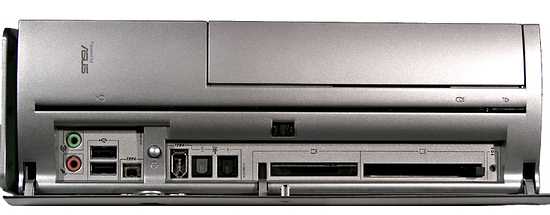 The opened front panel and the rear one indicate that this is a multimedia system rather than an office-type computer. Here is what it has in front (left to right): 2 Audio (headphones-out and mic-in), 2 USB (2.0), mini-FireWire (4-pin), Power button (the silvery button outside is not for opening the cover as you may think), FireWire (6-pin), S/PDIF Out, S/PDIF In (both are TosLink), 4-in-1 card reader (SM, MS, MMC, SD), PCMCIA slot and Reset button. Well, the design is well worked out: it seems that there are no more devices out there at all which can be connected to the front side. 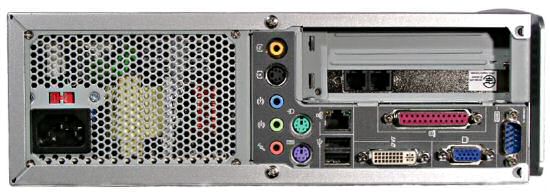 The rear panel houses 2 TV-Out (composite and S-Video), 3 Audio, 2 PS/2, 1 LAN, 2 USB (2.0), 1 LPT, 1 DVI, 1 VGA, 1 COM. However, not all connectors of the front side double on the back, and it can make the cover stay open for the whole time. There is also space for two extension cards and the power supply unit with the air vent which takes half of the rear panel - this is the only way out for the hot air. Now let's open the case... 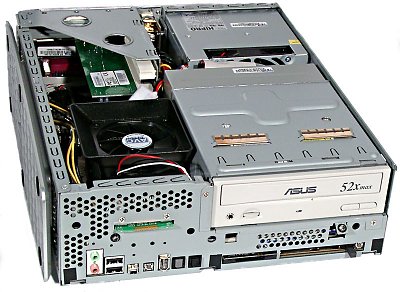 The model is tightly stuffed with various components, like the Prodigy's model. But you can face problems only with the board since it might be necessary to remove only one element of the design to access other components. The drives are housed in one tight rack, and the hard drive would hardly feel comfortable there being blocked by the CD/DVD drive and the mainboard. There are only two bays for disc drives, and only one IDE connector (and an FDD is lacking at all). The drives' rack is to be taken out, and then you have to spend certain time connecting the IDE cable and power cables. 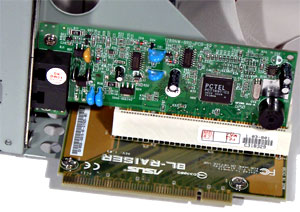 There is a riser card from one slot onboard to make possible to use two PCI extension cards (you can see on the photo the PCTel based soft-modem installed into the first slot). 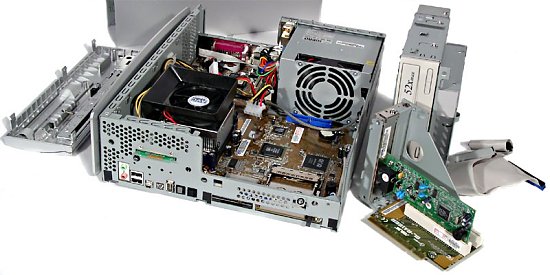 When we removed the riser card mount and the drive's rack we saw that the power supply unit and a big fan (80mm, mounted on the front panel, this is the only cooler there), take the most space there. 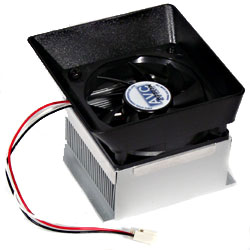 The processor's socket and its cooler are located in the opposite corner from the power supply unit. The cooler is made of aluminum with straight fins. It's made by the ASUS's favorite OEM partner - AVC, and it has a different air inlet jacket mounted right on the fan: the upper end of the device must be pressed to the PC case cover (though actually, it doesn't reach it) which has holes for taking in air from outside. Thanks to the Q-Fan technology, the cooler's frequency dynamically changes depending on the CPU's temperature, and the system works absolutely noiselessly when it stands idle (besides, 2200 rpm of the high-quality fan of a adequate diameter are not heard even under the load). 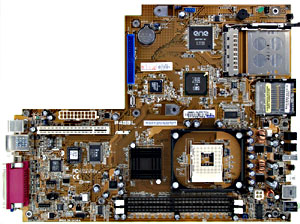 The textolite of the ASUS P4S8L mainboard is not rectangular because of the limited space inside. The board is based on the SiS651 (SiS651 + SiS962) and has quite advanced capabilities. It supports Celeron/Pentium 4 up to 533 MHz FSB, up to DDR333 (note that there are two memory slots, in contrast to many other boards with only one slot), USB 2.0, FireWire (with the external PHY controller Realtek 8801B), Fast Ethernet (up to 100 Mbit/s, on the external Broadcom 4401 chip), 6-channel audio (AC'97 codec ALC650). There is no AGP, and owners of the Pundit will have to go with the integrated SiS315 core which can't boast of its 3D at all. On the other hand, there is its chip-companion SiS301 for the TV-out and digital DVI interface for connecting LCD monitors or the like (this is an addition to the standard analog-out to monitor). Finally, exotic peripherals (PCMCIA, flash card reader) are supported by the ENE CB710Q chip. 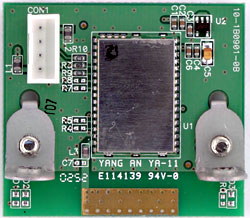 Besides, it's possible to attach to the front panel an optical Bluetooth module to extend the functionality even more. On the other hand, the BIOS settings look scarce, especially when compared with the usual desktop boards: a meticulous user might be interested only in the memory timings and its frequencies, manual distribution of interrupts among slots and FSB changing up to 166(!) MHz in 1MHz slots. In closing, have a look at the brief characteristics of this barebone system.
Iwill XP4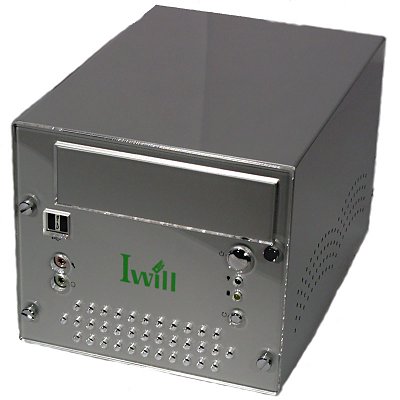 The Iwill's barebone reminds the XPC series though if you look inside you will notice the difference. The aluminum case is of the typical cubic shape, measuring 190x270x165 mm with a transparent plastic cover and 4 decorative bolts in front, vent holes in front and on the sides. The XP4 has a simple but austere style. 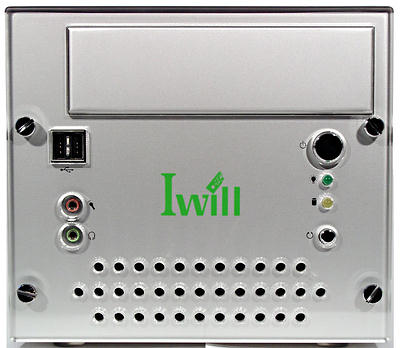 The front panel doesn't offer much: 2 USB (2.0) ports, line-out (for headphones) and mic-in. However, the power button is supplemented with the reset one. An external bay is only one - for 5" devices (you can try to install there a 3" one as well). Unfortunately, if you remove the bracket, the colors of the front cover and the device won't match. 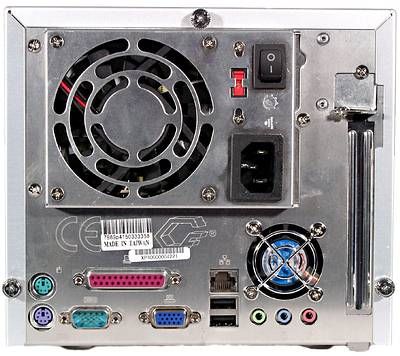 The connectors behind are standard: 2 PS/2, 1 LPT, 1 COM, 1 VGA, 1 LAN, 2 USB (2.0), 3 Audio. The power supply unit has a relatively big fan (for SFF computers) and a a power supply switch, one more smaller fan and an expansion card slot (I meaningly omit its format here). 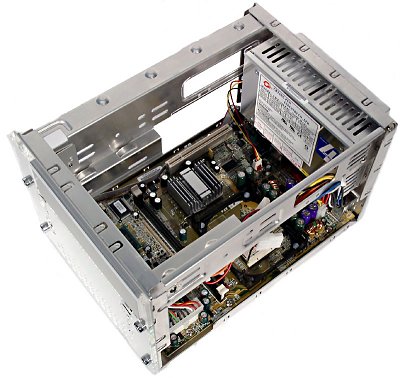 There is some difference from the XPC models: the power supply unit is pressed to the back panel; unfortunately, it has the vent holes only on its sides. Also, a big fan (a part of the CPU's I.C.E. cooler in the Shuttle XPC) is replaced with a small but high-quality Delta fan attached to the back panel. It's interesting that there are no any removable parts there - the design is excellently thought out. The components are attached either to the bottom or (CD/DVD and hard drives) to the mounts - even the rack is unnecessary there. The only I'd like to see there is two 3" bays instead of one (the board has two IDE connectors anyway, for 4 devices); it will also be possible then to separate the hard drive (or rather its hot cover) from the bottom of the optical drive, though it's necessary to have an additional power supply connector for the second hard drive. 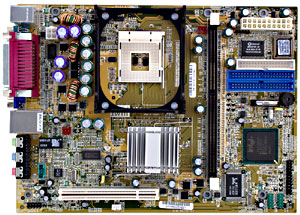 The Iwill XP4 board arranged on the bottom is based on the i845GV chipset (analog of the i845G, but without the external AGP cards support), supports FSB up to 533 MHz and DDR200/DDR266 memory. Note that Iwill has one more barebone system named XP4-G on the i845GE chipset. It supports the AGP slot and DDR333, and the Iwill XP4-G installed there has an identical layout, the only expansion slot is AGP. The XP4 has PCI in return. That is why you can choose a barebone you find more suitable. There is only one memory slot, an almost useless FDD connector and two IDE, though it can be difficult to connect and place two ATA66 cables. There are also external 6-channel AC'97 codec ALC650 and Realtek 8100B network controller. In the BIOS you can change only the memory timings, its clock speed, manually distribute interrupts among slots and change the FSB frequency up to 250 MHz in 1MHz steps. 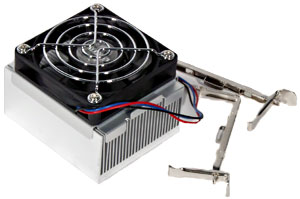 You can choose and install a cooler on the processor yourselves; we've received the system with the Evercool's one. And we decided to use this cooler in the tests, especially because the board was equipped with Pentium 4 2.4B GHz which is older and colder than the 3.06 GHz model, the maximum supported processor. The cooler's characteristics are not impressive: it has straight aluminum fins of the same height, a slow fan, but if the temperature mode is okey in such conditions, you won't have to worry at all. Also note that the small fan didn't tend to make up for its size by spinning up, and it didn't make much noise. According to the documentation, both rear fans in the XP4 adjust their rotations depending on the temperature inside the case. We couldn't find out how we could set the threshold for the fans to start up, but when the system booted up both fans started rotating without changing the speed afterwards. A bit later I'll tell you what was the result.
Here are the brief characteristics of this barebone system shipping in a usual cardboard box with a handle.
Shuttle XPC SN41G2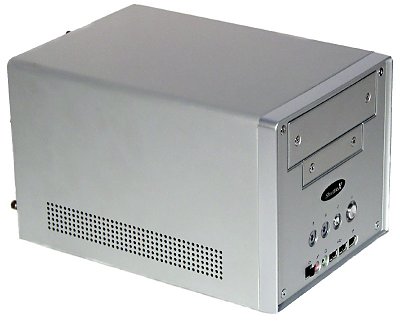 Some Shuttle's SFF models were already reviewed before, and it makes no sense to examine one more so closely. Although the XPC SN41G2 is meant for the Athlon XP processors, the only difference in design from the SS51G is the body's color, features of the board and the cooler. That is why we will dwell only upon these items. 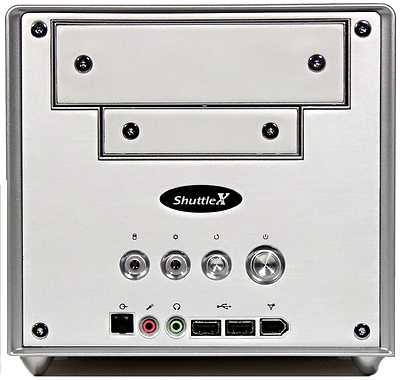 The gray-steel case made of aluminum measures 200x300x185 and has an S/PDIF-out, a mic-in, a line-out for headphones, 2 USB (2.0) and 1 FireWire port in front. A floppy drive of another color may spoil the appearance; however, two LEDs and power and reset buttons are in the single style. 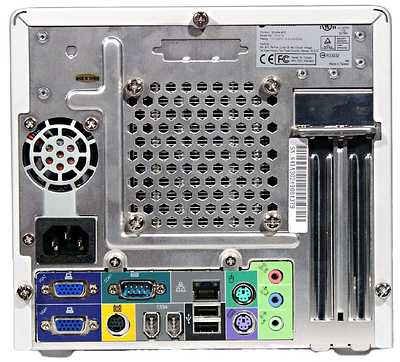 The back panel features a small fan of the power supply unit, a big fan of the upper heatsink of the CPU's cooler, space for two expansion cards and several connectors: two VGA-outs, TV-Out (S-Video), two FireWire, two USB, COM, LAN, 2 PS/2 and 3 standard audio connectors. You can probably guess what chipset is used on the SN41G2. :) 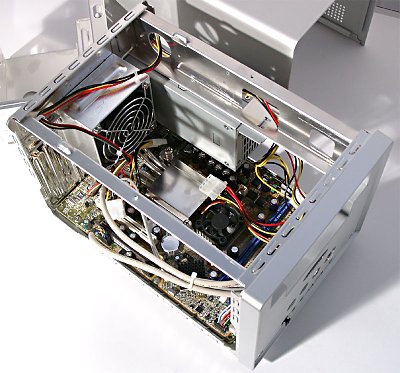 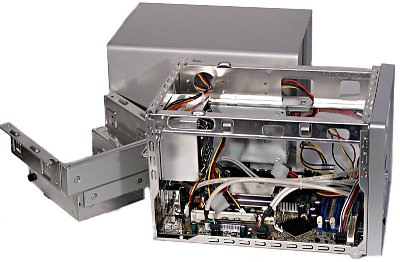 All the components are conveniently arranged inside, but the drive rack has to be moved out, which is a disadvantage as compared to Iwill's solution. However, the XPC has a bigger rack, for three drives, and supports any external 3" device (a card reader of the respective form factor looks probably best of all). 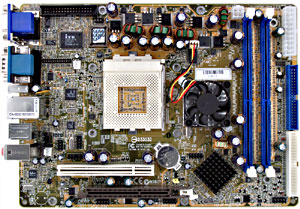 The Shuttle SN41G2 is based on the NVIDIA nForce2-GT chipset FN41. It supports any AMD Athlon XP processors, any memory mode up to 2xDDR400, an external video accelerator on the AGP 8x bus, up to two monitors (nView) and a TV-out in case of the integrated GeForce4 MX core, and a wide range of peripheral interfaces (6 USB 2.0 ports, 3 FireWire (Realtek 8801) ports, 10/100 Mbit Ethernet (Realtek 8201BL) and 6-channel sound (MCP-T and AC'97 codec Realtek ALC650)). The support of one AGP and one PCI typical of XPC distinguish this line of miniature computers and provides almost boundless expandability. 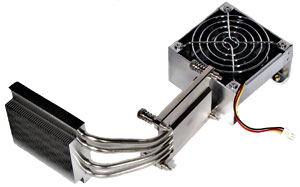 I wonder why they used this CPU cooler: the older XPC models which do not support the today's top Pentium 4 processors have a copper plate pressed into the base, and the latest model meant for the latest Athlon XP has an all-aluminum heatsink. According to the documentation at the Shuttle's site, the SN41G2 must go with the PH7 cooler, i.e. the one with the copper plate. Anyway, the thermal pipes technology works well - we'll discuss it a bit later. Also note that the chipset's bridges which heat up much have just heatsinks on, and the north bridge has a fan in addition. The overall noise level is not high, and when the processor stands idle the operation is very quiet (if the temperature falls below the threshold set in the BIOS, the fans selected reduce their speed). Finally, the BIOS settings. As you understand, overclockers will find nothing useful there. You can change memory timings, memory clock speeds in a wide range (all standard values of the nForce2), AGP bus settings, FSB up to 200 MHz in 1-2MHz steps.
Here are the brief characteristics of this barebone system shipping in a beautiful cardboard box with a handle.
Soltek Qbic EQ3000M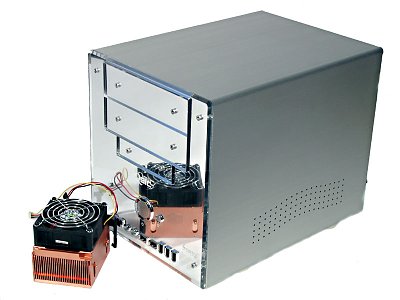 This is a typical product of the OEM cooperation. The barebone systems of the Soltek Qbic and Shuttle XPC series have so much in common (including the power supply unit), that it's much simpler to enumerate their differences. We won't examine the EQ3000M too closely, just get a general impression. 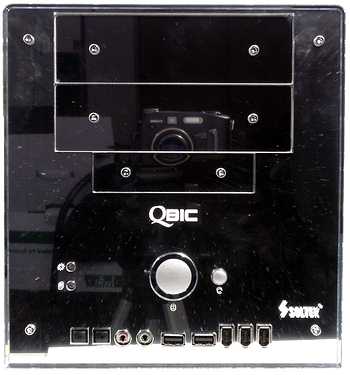 The removable cover is made of aluminum as well, but the front panel is redesigned: it's covered with a mirror layer (there is also a Qbic variant with a mat-white layer, such models are often indexed "-W"), and the connectors differ. We will always have an optical-in and S/PDIF-out, two standard audio connectors, 2 USB (2.0) ports and 3 (all three) FireWire at hand. This model has two bays for external 5" drives (in addition to 2 3" bays). On one hand, the conception of the miniPC doesn't work: the only thing to add is a couple of PCI slots to turn it into a full-size PC. On the other hand, Soltek also makes cubes of the standard size (for Shuttle) with one standard 5" bay (they are named "-2xxx-"), and the owners of the 3000 series won't have to make a choice between CD, DVD or combo drives. The typical downside of such models, and of the EQ3000M in particular, is that the stylish mirror exterior will be spoiled by external drives. 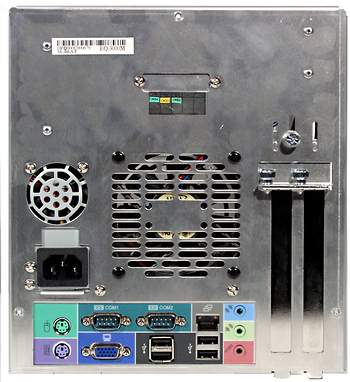 The back panel looks familiar: 2 PS/2, 2 COM (a rare case among barebone systems), analog-out for monitor, 4 USB (Soltek realizes the potential of the board's peripheral controllers entirely), LAN and 3 audio connectors. Next to them is a small fan of the power supply unit, a big fan (separately) and space for two expansion cards. 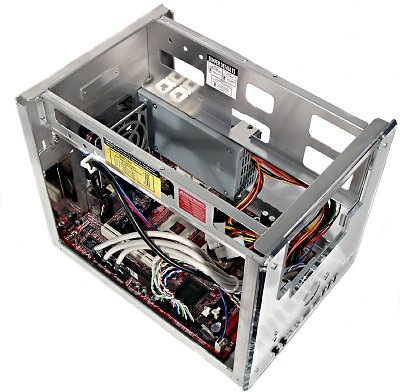 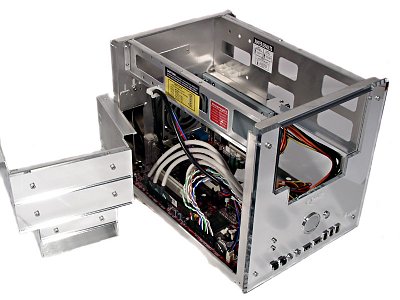 There are few changes inside as compared to any Shuttle G2 case: only the panels are higher and the drive racks are bigger now. Soltek takes the problem of cooling very seriously: it provides 2 ATA66 cables (one called "ATA100") with two connectors each (i.e. one cable for one IDE device) and one FDD cable - they are cut into stripes and tied up to ensure the optimal air flow inside. Well, even two standard ATA66 cables can be very harmful, that is why we are looking forward to the Serial ATA. Since the barebone PC is designed for three disc drives at least, you may need an IDE cable with three connectors (for 2 devices, plus one to the board), but such card is optional (also striped). The PC unit is cooled inside by a high-quality 75mm fan from ADDA with the temperature control supported. The cooler is attached right to the back panel since an I.C.E. cooler is not supplied. A processor cooler is lacking - Soltek does not probably worry about the Pentium 4 and lets users choose any cooler themselves (actually, you can order the same I.C.E. cooler). It's interesting that the EQ3701M (designed for Athlon XP) is supplied with a huge cooler with an all-copper heatsink. ;) 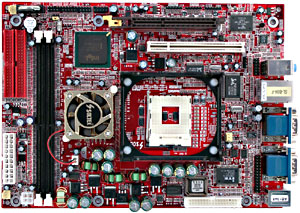 The Soltek's barebone computer certainly houses a Soltek's mainboard - B8A-F based on the i845GE. This chipset supports FSB up to 533 MHz, memory up to DDR333, an external video accelerator via the AGP 4x bus and integrated accelerator Intel Extreme Graphics with the core clock speed higher than that of the i845G(V). The peripherals support is ordinary: 6 USB 2.0 ports, 3 FireWire (Agere FW323-05), 10/100 Mbit Ethernet (Realtek 8100B) and 6-channel AC'97 sound (Realtek ALC650). One AGP and one PCI slots are certainly supported as well. The BIOS Setup doesn't have much to offer: memory timings, memory clock speed, manual distribution of interrupts among slots and FSB frequency changeable up to 200 MHz in 1MHz steps.
Here are the brief characteristics of this barebone system shipping
in a beautiful cardboard box with a handle.
PerformanceTestbed:
Software:
The performance tests are actually useless, because if you want to estimate the speed of the computers, you should check it up i our reviews of these chipsets. Sure boards based on the same chipset but produced by different companies can differ in the speed, but by 2-3% at most. It's also useless to test performance of the barebones as they are meant for different processors, and performance can often depend exactly on this component. However, we will test how flawless they work when almost all integrated capabilities are enabled (sound and video) in the complex applications loading various sections. The diagrams will demonstrate you one typical test of the memory controller, and a bit of 3D games where an integrated video accelerator always has an alternative. Note that the Shuttle worked in the dual-channel memory mode, while the models from ASUS and Soltek worked in the single-channel DDR333 and the Iwill had DDR266 (because of the chipset's limitations). The PCs from ASUS and Soltek show expected results, the Iwill goes behind because of the slower memory, and the Shuttle needs more CPU power (in this application the Athlon XP 2400+ is weaker than the Pentium 4 2.4B GHz). The most important thing in games is the absolute fps in the gaming modes. You can see that the graphics core is the same in the i845GE and in the i845GV (but it works at a lower frequency in the i845GV, and the Iwill has slower memory at that), and SiS315 (in SiS651) falls behind them in case of the mid-low graphics quality but outscores them in the mid-high one. But remember that none of these solutions has enough potential for modern 3D shooters. The nForce2-G is suitable as it scores 50 fps in 1024x768x32, just remember about the dual-channel memory mode. With an external video card almost all modes are suitable for games, but this question refers to the Video section. Temperature modeNow let's test the cooling systems. I must say that it's not going to be an absolute correct comparison because the Shuttle uses a processor of another architecture, which has completely different thermal characteristics. We can't compare the results of both processors used, but note that the typical heat generation of the AMD Athlon XP 2400+ is 62 W, and 57.8 W of the Intel Pentium 4 2.4B GHz. The similar coolers of the ASUS and Iwill worked equally, but the Iwill's cooler used for the Soltek behaved strangely: it excellently took off heat from the idling processor, but when the load was high enough, the cooler fell into the last position. Frankly speaking, I don't know why: actually, the overall design and size of the PC unit, and arrangement of the cooler's fins (perpendicular to the back panel) count in favor of the EQ3000M (when the processor stands idle the results are also good). I have nothing to say about the Shuttle's cooler, but when we tested the XPC models last time the I.C.E. coolers worked brilliantly. In general, the coolers coped well with the task maintaining the temperature at the acceptable level with the PC case closed and integrated video and audio enabled. Speaking about the temperature conditions, we shouldn't forget about other components. In this aspect, the way of direct heat removal from the processor with the I.C.E. cooler looks much worse than drawing air to the processor's heatsink (with the further distribution inside the case) in case of traditional coolers used in other barebones. The Shuttle's ventilation system consists of a big but slow fan attached to the back panel and a small one on the chipset, which tells on the mainboard's and hard drive's temperatures when the system starts working. The other contestants have obvious results: the electronic components feel worst in the tight Pundit, and the hard drive compressed in its tight rack looks very bad; the spacious PC case and excellent fan on the back of the Soltek's model distinguish the EQ3000M from the XP4 (besides, the hard drive of the XP4 is placed too close to the CD drive). Note that even with the hot GeForce4 Ti 4600 the temperatures in both barebones (AGP cards are supported only in the Shuttle and the Soltek models) remained far from the critical ones. ConclusionNone of the computers tested is a failure, and all of them and their variations can be recommended for use. Regarding the multimedia functions, the ASUS Pundit keeps the lead; the Shuttle and the Soltek follow it, and the Iwill XP4 is the least sophisticated solution. But the estimated price of the Iwill's computer is the lowest as well. The convenience of operation, speeds and temperature mode are discussed above, and you can choose what you find the most suitable for you. In closing, here is a brief list of the most typical strong and weak points of each barebone system. ASUS PunditHighs:
Lows:
Iwill XP4Highs:
Lows:
Shuttle XPC SN41G2Highs:
Lows:
Soltek Qbic EQ3000MHighs:
Lows:
Write a comment below. No registration needed!
|
Platform · Video · Multimedia · Mobile · Other || About us & Privacy policy · Twitter · Facebook Copyright © Byrds Research & Publishing, Ltd., 1997–2011. All rights reserved. |